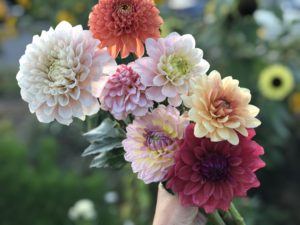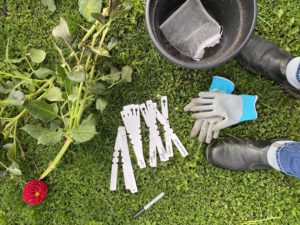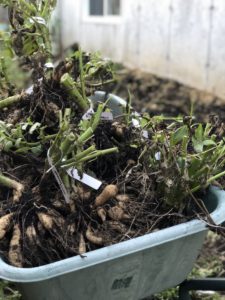How To Dig & Store Dahlias For Winter
Dahlias are incredible flowers in garden. They’re unbelievably beautiful from summer to frost, offering huge, showy blooms in a vast range of colours, shapes and sizes. They are outstanding as cut flowers, or as show-stopping drifts of late bloom in the garden. The only downside? They’re not hardy to our cold Ontario winters. When the freezing nights arrive, the dahlias need to be lifted and stored. Here’s how to dig & store dahlias for winter.

Preparing For Frost
Once dahlias get covered with frost, their flowers and leaves will blacken and die. Under the soil surface, however, their tuberous roots are storing energy, and can be lifted and saved to re-plant next spring. To prepare for this task, it’s a good idea to begin by labelling each plant with it’s variety name. Once dug, all tubers look nearly identical, so it’s important to know which is which! Use stakes, tags, or loop labels to write the name or colour of each plant before you dig.

Digging Dahlia Tubers
Once your plants are labelled, you can cut down the stems to 12-18″, giving you something to grab onto when you’re ready to dig. Then, using a spade or garden fork, dig into the soil approximately 1′ away from the plant’s stems. Work around the plant a few spade lengths, and then gently begin to lever the clump out of the ground. Lift the clump of tubers from the garden, and lightly shake away excess soil. If possible, let the tubers sit in the sun for a day. This helps by drying the soil to make it easier to remove, and “curing” the tubers for storage.


Storing Tubers Over Winter
There is more than one way to accomplish the storage of dahlia tubers over the winter. Some wrap in newspaper and store in a cellar, others will swear by a cold garage. The important considerations for winter storage are keeping the tubers from freezing, and storing them in a way that both prevents rotting and prevents drying out. Think of tubers like storing winter potatoes or onions! They need to be kept dry, cool, and dark.
Once cleaned off of most soil, trim away any dead, rotting, mouldy, or otherwise suspicious pieces from the tubers. Trim the stems down to the clump. If your clump is large, it can be divided into smaller pieces. In spring, each tuber with an “eye” (a tiny start of a future bud) can be planted individually. It’s often easiest to wait until spring to divide this far, as the “eyes” often form and swell through the winter. With the clumps relatively clean and dry, use a permanent marker to write the variety or colour on the tubers – it’s a simple and effective way to label them! Try storing in a plastic bin full of vermiculite or peat moss, kept in a cold, dark location that doesn’t freeze. Throughout the winter, check the tubers every 2-3 weeks to ensure they’re not rotting. Discard any problematic pieces right away.
Start Again In Spring
After the daffodils and tulips have bloomed and we’re preparing for summer planting, your dahlia tubers can be brought back to life! Removing them from their storage, asses the clumps and divide further, if desired. Plant into the garden (with “eyes” pointing up) after the soil has warmed and risk of frost has passed. Now that you know how to dig and store dahlias for winter, extra tubers make great gifts for friends and neighbours in spring! From a dormant state, dahlias can take a few weeks to fully wake up and start growing. Your patience is rewarded, though… soon your garden will be full of their bountiful blooms once again.
